 |
IMT711S- INTROMODAL TRANSPORTATION- 1ST OPP- JUNE |
 |
1 Page 1 |
▲back to top |
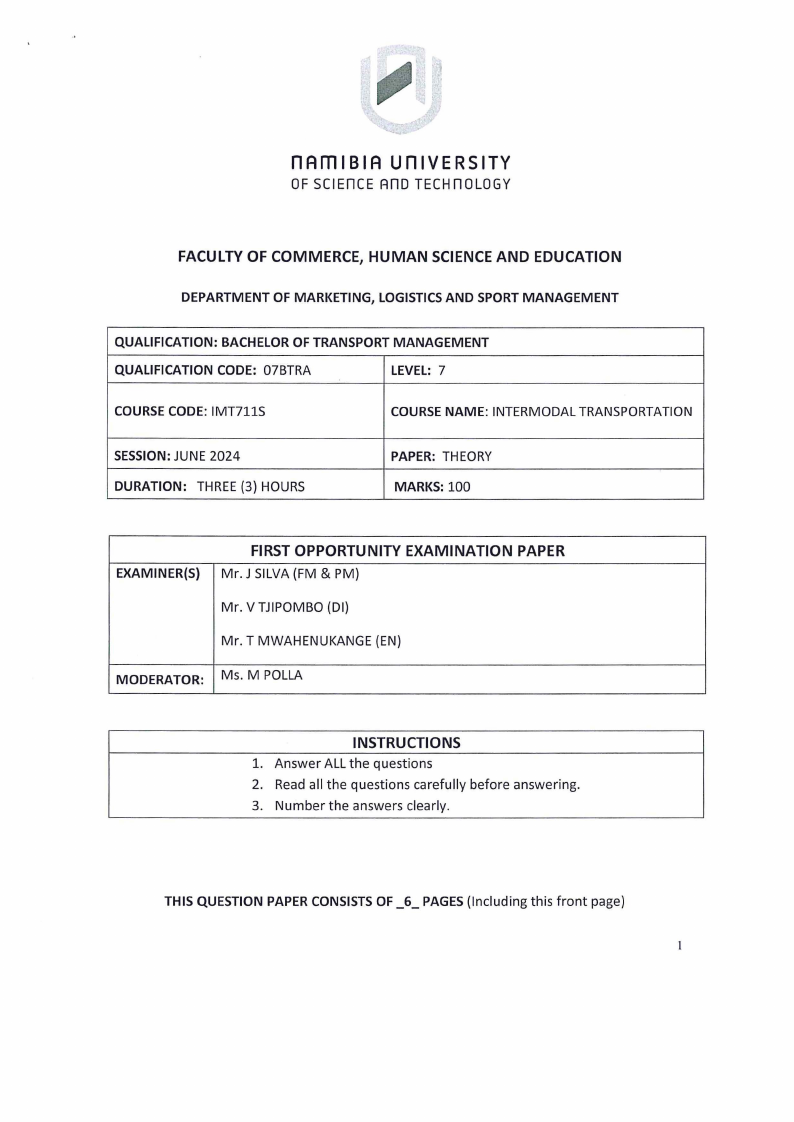
nAmlBIA UnlVERSITY
OF SCIEn CE Ano TECHn OLOGY
FACULTY OF COMMERCE, HUMAN SCIENCE AND EDUCATION
DEPARTMENT OF MARKETING, LOGISTICS AND SPORT MANAGEMENT
QUALIFICATION: BACHELOR OF TRANSPORT MANAGEMENT
QUALIFICATION CODE: 07BTRA
LEVEL: 7
COURSE CODE: IMT711S
COURSE NAME: INTERMODAL TRANSPORTATION
SESSION: JUNE 2024
DURATION: THREE (3) HOURS
PAPER: THEORY
MARKS: 100
EXAMINER(S)
FIRST OPPORTUNITY EXAMINATION PAPER
Mr. J SILVA (FM & PM)
Mr. V TJIPOMBO (DI)
Mr. T MWAHENUKANGE (EN)
MODERATOR: Ms. M POLLA
INSTRUCTIONS
1. Answer ALL the questions
2. Read all the questions carefully before answering.
3. Number the answers clearly.
THIS QUESTION PAPER CONSISTS OF _6_ PAGES (Including this front page)
 |
2 Page 2 |
▲back to top |
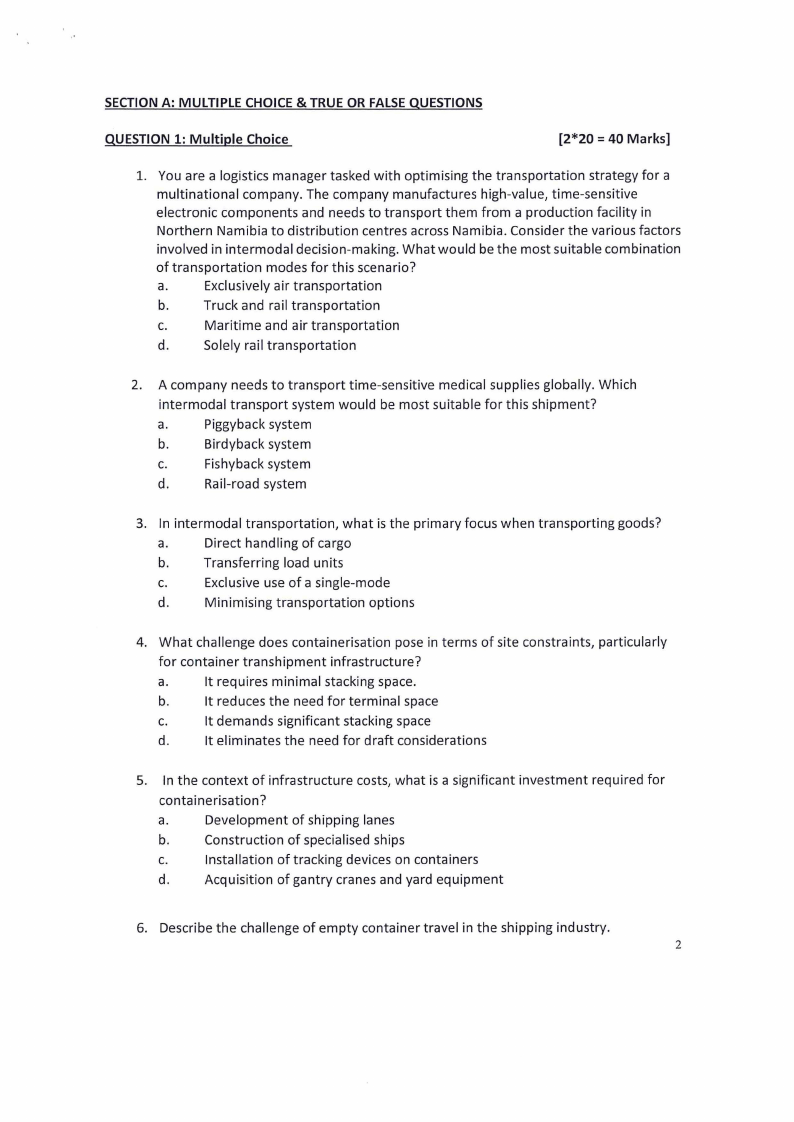
SECTION A: MULTIPLE CHOICE & TRUE OR FALSE QUESTIONS
QUESTION 1: Multiple Choice
[2*20 = 40 Marks]
l. You are a logistics manager tasked with optimising the transportation strategy for a
multinational company. The company manufactures high-value, time-sensitive
electronic components and needs to transport them from a production facility in
Northern Namibia to distribution centres across Namibia. Consider the various factors
involved in intermodal decision-making. What would be the most suitable combination
of transportation modes for this scenario?
a.
Exclusively air transportation
b.
Truck and rail transportation
c.
Maritime and air transportation
d.
Solely rail transportation
2. A company needs to transport time-sensitive medical supplies globally. Which
intermodal transport system would be most suitable for this shipment?
a.
Piggyback system
b.
Birdyback system
c.
Fishyback system
d.
Rail-road system
3. In intermodal transportation, what is the primary focus when transporting goods?
a.
Direct handling of cargo
b.
Transferring load units
c.
Exclusive use of a single-mode
d.
Minimising transportation options
4. What challenge does containerisation pose in terms of site constraints, particularly
for container transhipment infrastructure?
a.
It requires minimal stacking space.
b.
It reduces the need for terminal space
c.
It demands significant stacking space
d.
It eliminates the need for draft considerations
5. In the context of infrastructure costs, what is a significant investment required for
containerisation?
a.
Development of shipping lanes
b.
Construction of specialised ships
c.
Installation of tracking devices on containers
d.
Acquisition of gantry cranes and yard equipment
6. Describe the challenge of empty container travel in the shipping industry.
2
 |
3 Page 3 |
▲back to top |
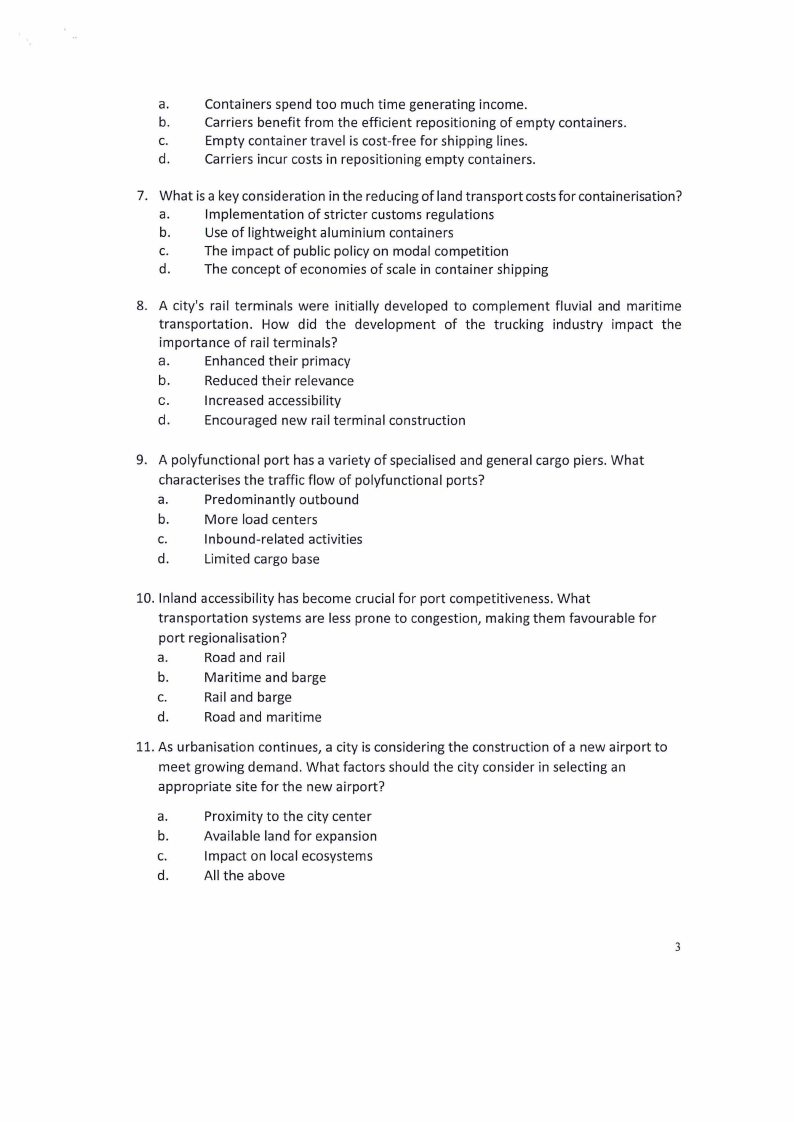
a.
Containers spend too much time generating income.
b.
Carriers benefit from the efficient repositioning of empty containers.
c.
Empty container travel is cost-free for shipping lines.
d.
Carriers incur costs in repositioning empty containers.
7. What is a key consideration in the reducing of land transport costs for containerisation?
a.
Implementation of stricter customs regulations
b.
Use of lightweight aluminium containers
c.
The impact of public policy on modal competition
d.
The concept of economies of scale in container shipping
8. A city's rail terminals were initially developed to complement fluvial and maritime
transportation. How did the development of the trucking industry impact the
importance of rail terminals?
a.
Enhanced their primacy
b.
Reduced their relevance
c.
Increased accessibility
d.
Encouraged new rail terminal construction
9. A polyfunctional port has a variety of specialised and general cargo piers. What
characterises the traffic flow of polyfunctional ports?
a.
Predominantly outbound
b.
More load centers
c.
Inbound-related activities
d.
Limited cargo base
10. Inland accessibility has become crucial for port competitiveness. What
transportation systems are less prone to congestion, making them favourable for
port regionalisation?
a.
Road and rail
b.
Maritime and barge
c.
Rail and barge
d.
Road and maritime
11. As urbanisation continues, a city is considering the construction of a new airport to
meet growing demand. What factors should the city consider in selecting an
appropriate site for the new airport?
a.
Proximity to the city center
b.
Available land for expansion
c.
Impact on local ecosystems
d.
All the above
3
 |
4 Page 4 |
▲back to top |
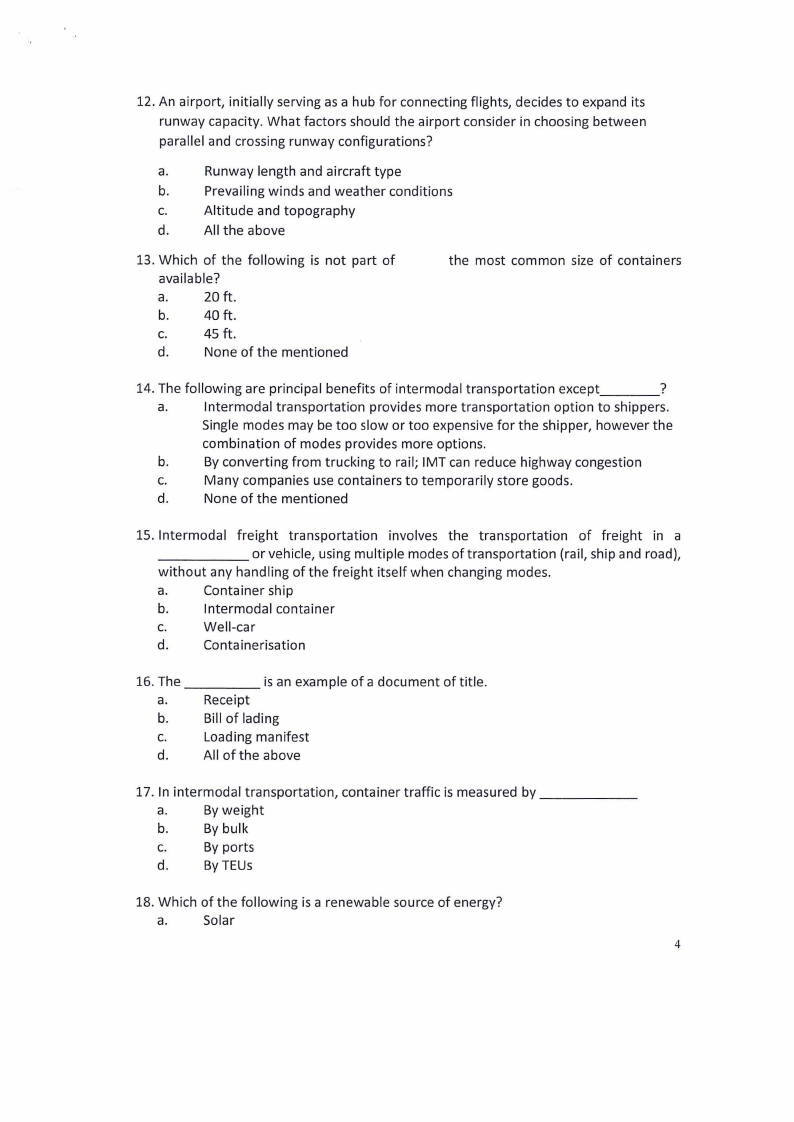
12. An airport, initially serving as a hub for connecting flights, decides to expand its
runway capacity. What factors should the airport consider in choosing between
parallel and crossing runway configurations?
a.
Runway length and aircraft type
b.
Prevailing winds and weather conditions
c.
Altitude and topography
d.
All the above
13. Which of the following is not part of
available?
a.
20 ft.
b.
40 ft.
C.
45 ft.
d.
None of the mentioned
the most common size of containers
14. The following are principal benefits of intermodal transportation except ____ ?
a.
lntermodal transportation provides more transportation option to shippers.
Single modes may be too slow or too expensive for the shipper, however the
combination of modes provides more options.
b.
By converting from trucking to rail; IMT can reduce highway congestion
c.
Many companies use containers to temporarily store goods.
d.
None of the mentioned
15. lntermodal freight transportation involves the transportation of freight in a
______
or vehicle, using multiple modes of transportation (rail, ship and road),
without any handling of the freight itself when changing modes.
a.
Container ship
b.
lntermodal container
c.
Well-car
d.
Containerisation
16. The _____
is an example of a document of title.
a.
Receipt
b.
Bill of lading
c.
Loading manifest
d.
All of the above
17. In intermodal transportation, container traffic is measured by _____
_
a.
By weight
b.
By bulk
c.
By ports
d.
By TEUs
18. Which of the following is a renewable source of energy?
a.
Solar
4
 |
5 Page 5 |
▲back to top |
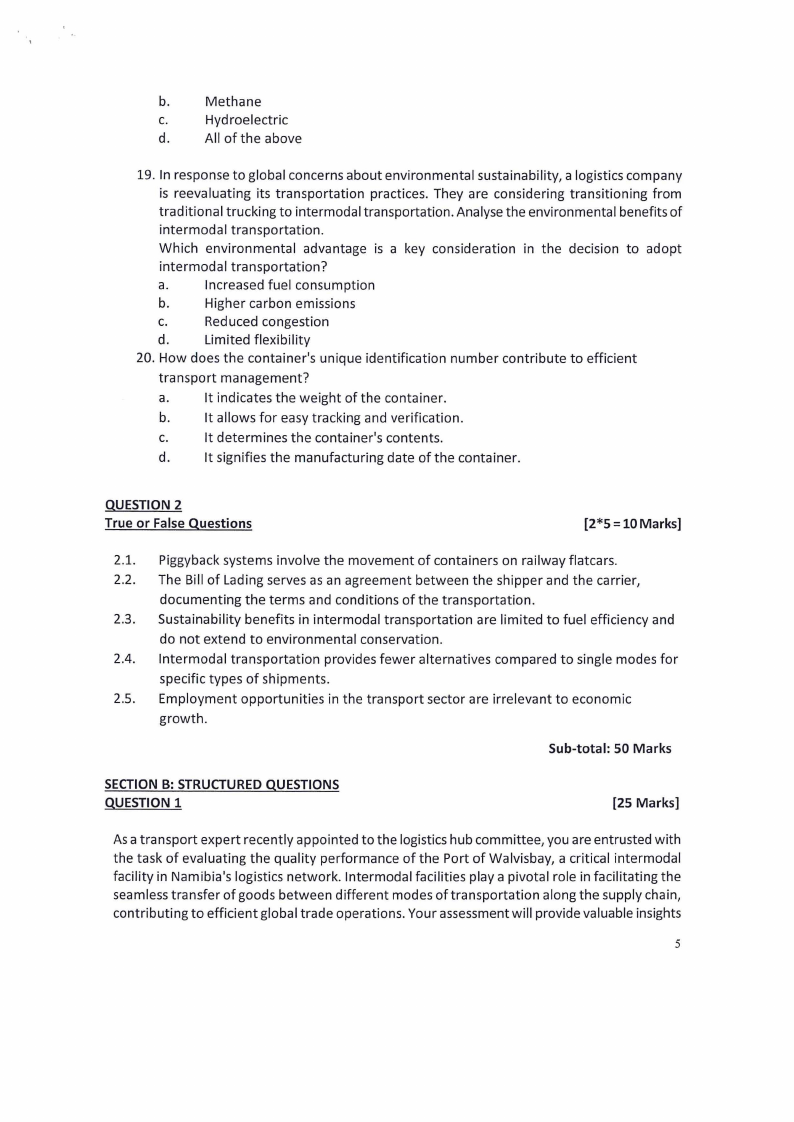
b.
Methane
c.
Hydroelectric
d.
All of the above
19. In response to global concerns about environmental sustainability, a logistics company
is reevaluating its transportation practices. They are considering transitioning from
traditional trucking to intermodal transportation. Analyse the environmental benefits of
intermodal transportation.
Which environmental advantage is a key consideration in the decision to adopt
intermodal transportation?
a.
Increased fuel consumption
b.
Higher carbon emissions
c.
Reduced congestion
d.
Limited flexibility
20. How does the container's unique identification number contribute to efficient
transport management?
a.
It indicates the weight of the container.
b.
It allows for easy tracking and verification.
c.
It determines the container's contents.
d.
It signifies the manufacturing date of the container.
QUESTION 2
True or False Questions
[2*5 = 10 Marks]
2.1. Piggyback systems involve the movement of containers on railway flatcars.
2.2. The Bill of Lading serves as an agreement between the shipper and the carrier,
documenting the terms and conditions of the transportation.
2.3. Sustainability benefits in intermodal transportation are limited to fuel efficiency and
do not extend to environmental conservation.
2.4. lntermodal transportation provides fewer alternatives compared to single modes for
specific types of shipments.
2.5. Employment opportunities in the transport sector are irrelevant to economic
growth.
Sub-total: 50 Marks
SECTION B: STRUCTURED QUESTIONS
QUESTION 1
[25 Marks]
As a transport expert recently appointed to the logistics hub committee, you are entrusted with
the task of evaluating the quality performance of the Port of Walvisbay, a critical intermodal
facility in Namibia's logistics network. lntermodal facilities play a pivotal role in facilitating the
seamless transfer of goods between different modes of transportation along the supply chain,
contributing to efficient global trade operations. Your assessment will provide valuable insights
5
 |
6 Page 6 |
▲back to top |
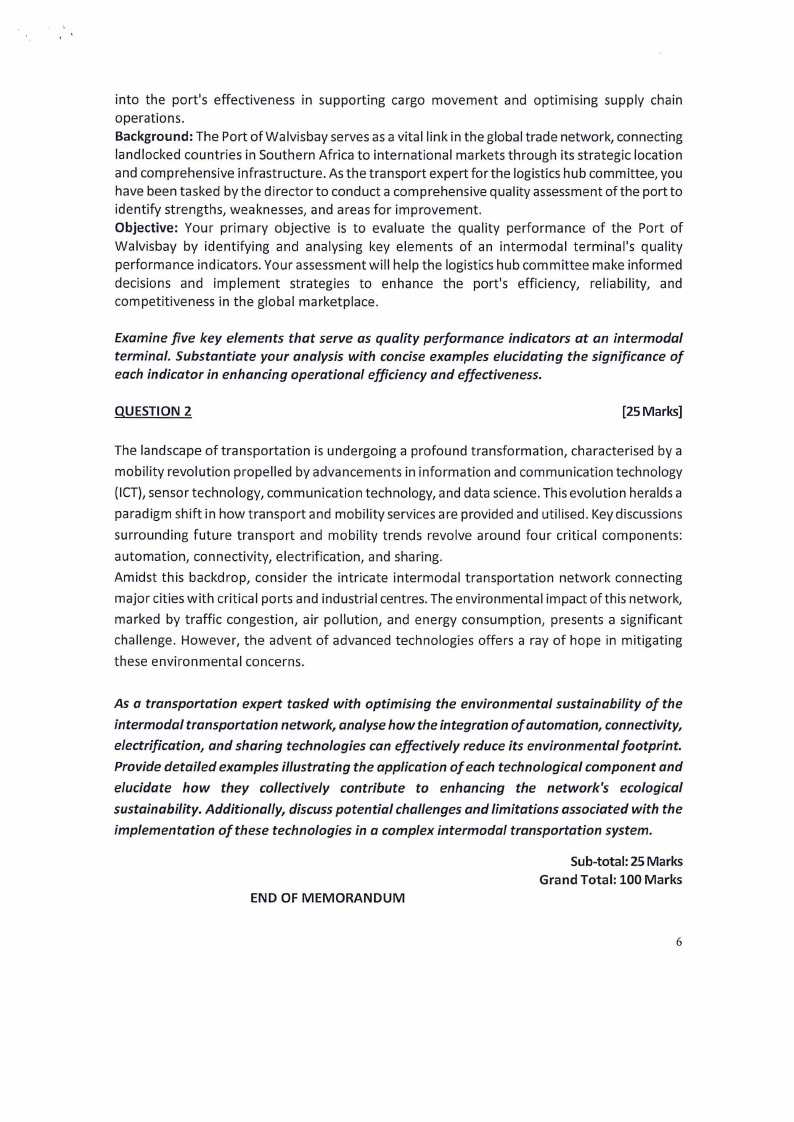
into the port's effectiveness in supporting cargo movement and optimising supply chain
operations.
Background: The Port of Walvis bay serves as a vital link in the global trade network, connecting
landlocked countries in Southern Africa to international markets through its strategic location
and comprehensive infrastructure. As the transport expert for the logistics hub committee, you
have been tasked by the directorto conduct a comprehensive quality assessment of the port to
identify strengths, weaknesses, and areas for improvement.
Objective: Your primary objective is to evaluate the quality performance of the Port of
Walvisbay by identifying and analysing key elements of an intermodal terminal's quality
performance indicators. Your assessment will help the logistics hub committee make informed
decisions and implement strategies to enhance the port's efficiency, reliability, and
competitiveness in the global marketplace.
Examine five key elements that serve as quality performance indicators at an intermodal
terminal. Substantiate your analysis with concise examples elucidating the significance of
each indicator in enhancing operational efficiency and effectiveness.
QUESTION 2
[25Marks]
The landscape of transportation is undergoing a profound transformation, characterised by a
mobility revolution propelled by advancements in information and communication technology
(ICT},sensor technology, communication technology, and data science.This evolution heralds a
paradigm shift in how transport and mobility services are provided and utilised. Key discussions
surrounding future transport and mobility trends revolve around four critical components:
automation, connectivity, electrification, and sharing.
Amidst this backdrop, consider the intricate intermodal transportation network connecting
major cities with critical ports and industrial centres. The environmental impact of this network,
marked by traffic congestion, air pollution, and energy consumption, presents a significant
challenge. However, the advent of advanced technologies offers a ray of hope in mitigating
these environmental concerns.
As a transportation expert tasked with optimising the environmental sustainability of the
intermodal transportation network, analyse how the integration of automation, connectivity,
electrification, and sharing technologies can effectively reduce its environmental footprint.
Provide detailed examples illustrating the application of each technological component and
elucidate how they collectively contribute to enhancing the network's ecological
sustainability. Additionally, discuss potential challenges and limitations associated with the
implementation of these technologies in a complex intermoda/ transportation system.
END OF MEMORANDUM
Sub-total: 25 Marks
Grand Total: 100 Marks
6





